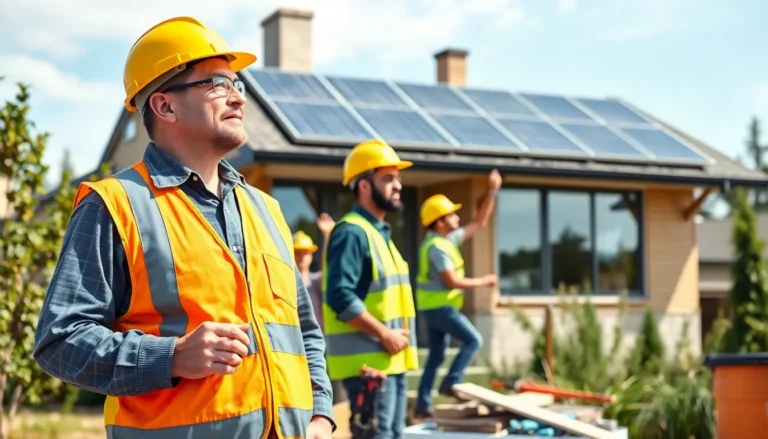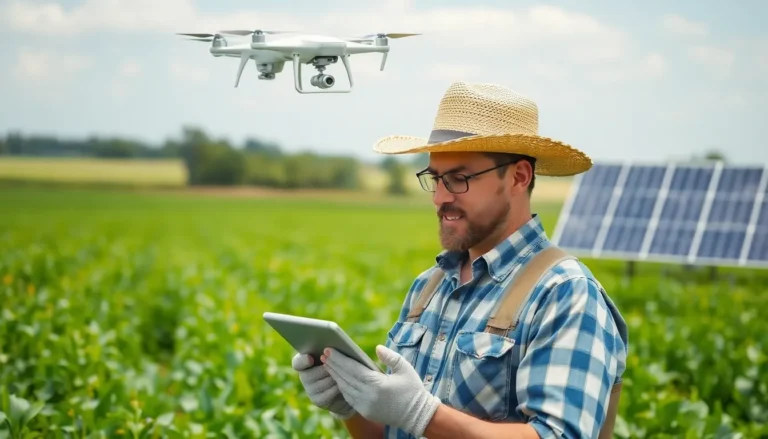Table of Contents
ToggleIn a world where gadgets seem to multiply faster than rabbits, sustainable technology emerges as the superhero we didn’t know we needed. Imagine a tech realm where innovation meets eco-friendliness—no more choosing between a sleek smartphone and saving the planet. It’s like having your cake and eating it too, but this cake is made from organic ingredients!
What Is Sustainable Technology?
Sustainable technology refers to innovations designed to minimize environmental impact while maximizing efficiency. It encompasses a range of solutions that promote energy conservation and reduce waste. Many industries now prioritize these technologies to align with eco-friendly practices.
Renewable energy sources, such as solar panels and wind turbines, exemplify sustainable technology. These systems harness natural resources, offering cleaner alternatives to fossil fuels. Additionally, energy-efficient appliances use less power, resulting in lower emissions and reduced utility bills.
Transportation also benefits from sustainable technology. Electric vehicles represent a significant shift toward reducing greenhouse gas emissions. Charging infrastructure has expanded, making it easier for consumers to adopt electric cars.
In construction, sustainable building materials play a vital role. Bamboo, recycled steel, and reclaimed wood offer environmentally friendly alternatives to traditional materials. These choices help reduce deforestation and minimize carbon footprints in new developments.
Information technology sectors innovate with sustainable practices as well. Cloud computing reduces energy consumption by optimizing resource use across multiple users. Data centers are adopting advanced cooling techniques to enhance efficiency and lower energy demands.
End-of-life recycling programs ensure that products are disposed of responsibly. Manufacturers are increasingly implementing take-back schemes to encourage consumers to return used electronics. Such initiatives help divert waste from landfills and support the circular economy.
Sustainable technology fosters a future where economic growth aligns with environmental stewardship. By prioritizing sustainability, businesses and individuals contribute to a healthier planet. The ongoing commitment to these practices shapes a resilient society, demonstrating that technology and the environment can coexist harmoniously.
Key Principles of Sustainable Technology

Sustainable technology integrates three key principles: environmental impact, economic viability, and social equity.
Environmental Impact
Environmental impact focuses on minimizing harm to ecosystems. Technologies, like solar panels and wind turbines, harness renewable resources, reducing reliance on fossil fuels. Energy-efficient appliances lower utility costs and cut emissions. Materials such as bamboo and recycled steel in construction help decrease carbon footprints. Practices like cloud computing optimize energy usage in information technology. Encouraging end-of-life recycling programs promotes responsible disposal of electronics, supporting a circular economy.
Economic Viability
Economic viability emphasizes cost-effectiveness in sustainable technologies. Initial investments in renewable energy often lead to long-term savings for consumers and businesses. For instance, electric vehicles lower fuel expenses while qualifying for various incentives. Companies embracing sustainable practices often experience enhanced brand loyalty and competitiveness. Additionally, innovation in green technologies drives job creation in sectors like renewable energy and sustainable construction. These investments contribute to economic growth while supporting environmental sustainability.
Social Equity
Social equity ensures that all communities benefit from sustainable technology. Accessibility to clean energy sources and energy-efficient appliances must be equitable. Policies promoting renewable energy often address low-income neighborhoods, allowing broader community access. Participation in green job training programs empowers marginalized groups, fostering inclusivity in the green economy. Ensuring everyone has access to sustainability initiatives supports social responsibility while improving overall quality of life. Sustainable technology ultimately bridges the gap between environmental responsibility and social justice.
Examples of Sustainable Technologies
Sustainable technology manifests in various forms, each contributing positively to environmental preservation.
Renewable Energy Sources
Solar panels harness sunlight to generate electricity, representing a key advancement in clean energy. Wind turbines capture wind energy, producing significant power without harmful emissions. Hydroelectric plants utilize flowing water to generate electricity, offering an efficient alternative to fossil fuels. Geothermal systems tap into the Earth’s heat for heating and power generation, reducing reliance on non-renewable sources. Together, these technologies present cleaner choices, significantly lowering greenhouse gas emissions and supporting a shift toward greener energy solutions.
Energy-Efficient Systems
Energy-efficient appliances reduce electricity consumption while maintaining performance. LED lighting uses up to 80% less energy than traditional bulbs, delivering brighter illumination at lower costs. Smart thermostats optimize heating and cooling schedules, leading to substantial energy savings. High-efficiency HVAC systems minimize energy use, improving indoor comfort while contributing to lower utility bills. Such systems not only benefit users economically but also promote sustainability by decreasing overall energy demand.
Benefits of Sustainable Technology
Sustainable technology offers numerous advantages for both the environment and society. These innovations contribute significantly to a greener future while improving overall quality of life.
Reducing Carbon Footprint
Reducing carbon footprints stands as a primary benefit of sustainable technology. Electric vehicles lower emissions compared to traditional gasoline-powered cars, leading to cleaner air. Solar panels generate renewable energy, greatly decreasing reliance on fossil fuels. Eco-friendly construction materials, like bamboo and recycled steel, further contribute to minimizing greenhouse gas emissions. Implementing energy-efficient appliances cuts down electricity consumption and costs, benefiting both users and the environment alike. Collectively, these technologies play a vital role in achieving climate goals and sustaining the planet for future generations.
Promoting Innovation
Promoting innovation represents another key benefit of sustainable technology. Businesses that adopt green technologies often experience new growth opportunities through advanced solutions. Renewable energy advancements drive job creation in the burgeoning clean energy sector. Smart technology, like energy management systems, enhances efficiency in numerous industries, optimizing resource use and reducing waste. Sustainable practices stimulate research and development, leading to breakthroughs that enhance both productivity and environmental health. Prioritizing these technologies fosters a culture of creativity and responsibility, enabling societies to thrive.
Challenges in Implementing Sustainable Technology
Implementing sustainable technology presents various challenges that can hinder progress. Tackling these obstacles is crucial for achieving environmental goals.
Cost Barriers
High initial costs often deter businesses from adopting sustainable technologies. Many companies face significant capital investment for renewable energy systems or energy-efficient appliances. Budget constraints influence decision-making, leading some organizations to prioritize short-term savings over long-term benefits. Despite the potential for cost savings through reduced energy consumption, the upfront financial burden remains a substantial barrier. In addition, smaller enterprises may lack access to financing options, further complicating their ability to invest in sustainable solutions.
Regulatory Hurdles
Complex regulations frequently impede the advancement of sustainable technology. Compliance with existing laws can pose challenges for businesses looking to innovate. Many sectors face strict guidelines that may not align with emerging green technologies. Regulatory inconsistencies across regions create confusion and limit scalability of sustainable practices. Industries often struggle to navigate these regulations, causing delays in project implementation. Furthermore, a lack of incentives for adopting sustainable technology can discourage many companies from pursuing eco-friendly options.
Sustainable technology is reshaping the future by marrying innovation with environmental responsibility. As industries embrace eco-friendly practices they pave the way for a greener economy that benefits everyone. By prioritizing renewable energy and energy-efficient solutions individuals and businesses can significantly reduce their carbon footprints while enjoying the advantages of modern technology.
The journey toward sustainability isn’t without challenges but the potential rewards make it a worthy pursuit. With continued investment in sustainable practices and a commitment to overcoming obstacles society can create a harmonious balance between technological advancement and environmental stewardship. Embracing sustainable technology today lays the foundation for a cleaner healthier planet for future generations.







